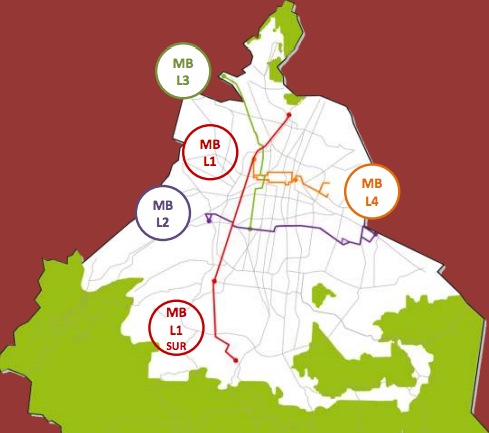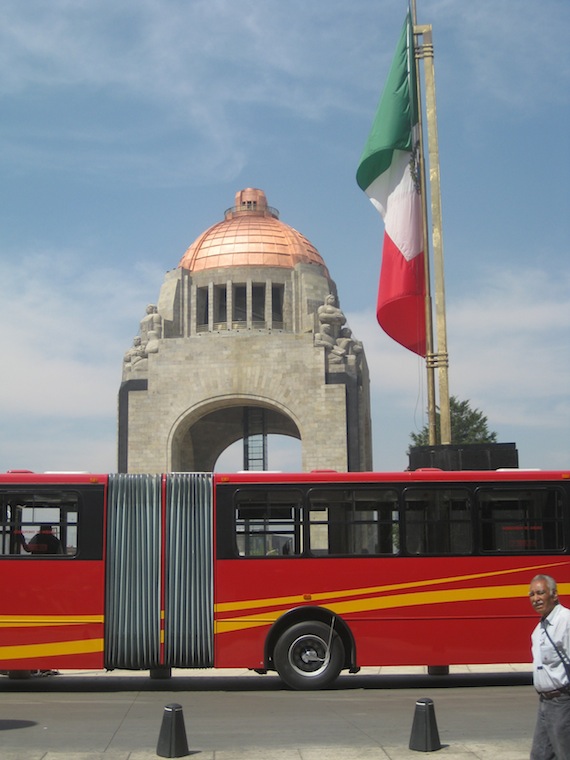
This is the second in a series of reports about sustainable transportation policies in Mexico City. Last week, Streetsblog participated in a tour of the city led by the Institute for Transportation and Development Policy and funded by the Rockefeller Foundation. A previous installment covered pedestrian improvements in the city and a third will discuss its bicycle planning.
After a precipitous collapse, buses are on the rebound in Mexico City.
When the city's public bus system fell apart during the political and economic turmoil of the 80s and 90s, Mexico City residents were left to rely on a fleet of private microbuses that was extensive but slow, dangerous, and heavily polluting. Now, the city is quickly building out a bus rapid transit system called Metrobús that's making surface transit fast, safe, and healthy. "It's the most important initiative in the city in the last 25 years," says Mayor Marcelo Ebrard.
On the Avenida de Insurgentes, where the first Metrobús line opened in 2006, the distinctive red buses pass by in continuous streams, even when it's not rush hour. At midday, the gap between one bus and the next was rarely longer than the time it takes to load and unload passengers at the previous station or to wait at a red light. Each bus was full. Clearly, demand is high, perhaps higher than the system can handle.
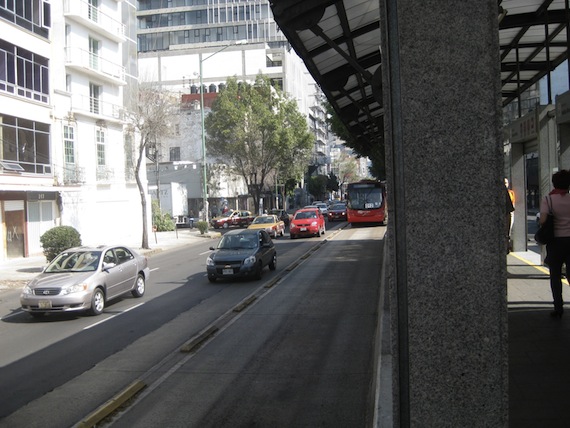
Each of the three Metrobús lines offers a full set of bus rapid transit features. Riders cross to the median of a wide avenue, where buses run in each direction on physically separated lanes. A ramp leads up to an enclosed station, where you tap a smart card against the turnstile to enter.
Once the bus arrives, its wide doors open down the length of the vehicle, passengers quickly exit and enter, and the bus pulls away. The long, straight avenue and stations in the median mean the driver rarely has to even turn the wheel; it's a very smooth trip for a bus.
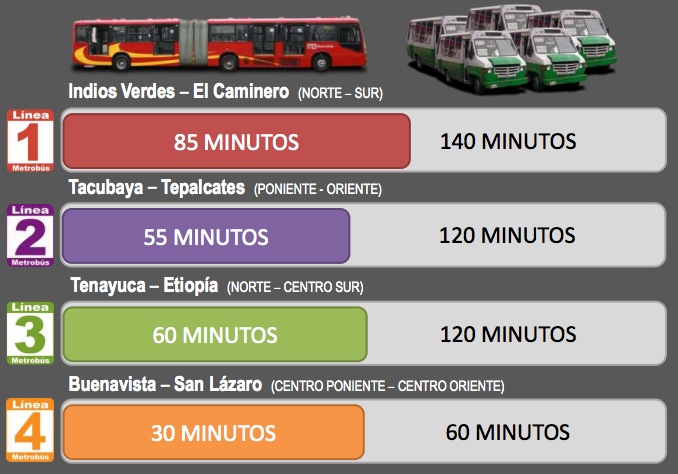
The results speak both to the efficiency of the operation and the chaos that generally reigns on Mexico City streets. On Insurgentes, giving three lanes of traffic to Metrobús operations actually improved speeds for both transit and private automobiles. Speeds rose from an average of only 12 kilometers per hour for mixed traffic to 17 kph for cars and 20 kph for buses, according to Metrobús official Gonzalo Garcia Miaja. A trip down the full 30 kilometer corridor used to take 140 minutes. Now, it takes only 85 -- and Insurgentes saw the smallest improvement in travel times of any Metrobus line. Property values are up along the route, according to Walter Hook, the CEO of the Institute for Transportation and Development Policy.

The trick was taking the private microbuses, which snarl traffic by darting back and forth across the street in search of one more fare, off the road. With all buses sticking to one lane, traffic moves more smoothly for everyone. It also moves more safely. "The microbus rides like he wants," said Miaja. "They are literally killing themselves to get more passengers." Traffic crashes and injuries are down significantly along Metrobús corridors, he said, though they're far from zero.

The ubiquity of microbuses on Mexico City streets dates back to the mid-1980s. Before then, the city had a publicly run system of buses. Buffeted on one side by a left-wing union that sided with the Zapatista uprising of 1994 and on the other by the wave of privatization that swept through the country under President Carlos Salinas, the system fell apart. In 1986, 42 percent of trips in Mexico City took place on a high-capacity bus; by 1994, that number had plummeted to just 10 percent. Microbuses picked up all the slack and more.
Moving from microbus to Metrobús has also proved important for air quality, a critical issue in a city that had some of the worst smog in the world. According to Miaja, the newest models being put out on the street by Metrobús are 95 percent cleaner than buses being sold in 1993, the year the very newest microbuses on the road were produced.
Air pollution is easing up in Mexico City now, thanks not only to better transportation options but improved automotive technologies, heavy industry's departure from the city, and tough policies like Hoy No Circula, which forbids each car to drive one day a week. The ring of mountains that surround Mexico City are still cloaked in a grey-blue haze, but the heavy, eye-stinging smog that many travelers remember is, increasingly, a thing of the past.
Even with extensive infrastructure, however, the system is now approaching its limits. The Insurgentes line is essentially at capacity; though Mayor Ebrard announced the addition of some newer, larger buses for the system just last week, the only way to significantly add service along the route, according to ITDP's Annie Weinstock, would be to build new passing lanes in each direction, allowing express service.
When the fourth Metrobús line opens this year, the city expects to have 201 million passengers riding the system a year. The ridership is enormous but adds up to less than three of Mexico City's eleven subway lines.
The constraints inherent in surface transit are clear. The buses must wait at red lights to allow traffic and pedestrians to cross the street, slowing trips. "You can't do transit signal priority," said Weinstock, referring to systems which extend green lights for approaching buses. "You would never have cross traffic." At one point on our tour, a street protest blocked the Metrobús line in one direction; our group was forced to walk.

Mexico City is not standing still, continuing to expand its transit system both below ground and on the street. A twelfth subway line will open this summer, as will a fourth Metrobús line. In 2010, the city launched a new public bus service, named Ecobus for using clean fuels, which runs in mixed traffic.
Ebrard identified the relatively low cost of Metrobús operations as an advantage over further subway construction. At a five peso fare, equal to about 40 cents, the system turns an operating profit. Private operators -- collectives made up of the minibus drivers who formerly drove each route -- get all fare revenues, which then pay for their labor, fuel, maintenance, and most of the buses themselves, explained Miaja. The government only pays for the street and station infrastructure. In contrast, the city subsidizes its Metro system at a cost of about US$300 million a year.

The new Metrobús line set to open will function slightly differently than the first three. Rather than offering the full bus rapid transit package, the new line will dispense with large stations and off-board fare payment while keeping the physically separated bus lanes. Because the line runs through Mexico City's historic downtown, finding the space for the more intense infrastructure and squaring it with historic preservation laws proved unfeasible. At one point, Line 4 will run as a two-way bus mall, without any private car access. It will also improve transit access to the airport; right now, only one terminal is directly accessible from the subway.
The fourth line of the Metrobús will run just blocks away from the Calle Regina, a pedestrianized street downtown that Streetsblog described in a previous post. In both cases, street space was being used less for vehicle throughput than as unauthorized market space. "The streets were absolutely immobilized with street vendors," said Hook. By our visit, the vendors had been cleared and construction was underway on the bus infrastructure.
On Mexico City streets, evidently, conflict isn't only between different modes competing for scarce real estate. As important is the battle between the formal and informal sectors of the economy. Squatting vendors and private minibuses vie for street space with the customers of bricks-and-mortar merchants and systematized public transit. In clearing the first group to make way for the second, Mexico City is simultaneously improving mobility and sustainability while extending government control over new spaces.
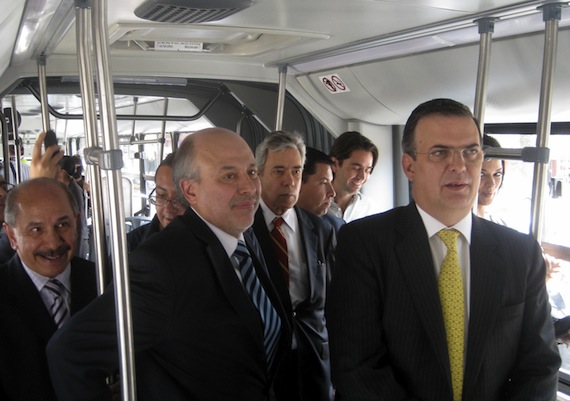
Even if the Metrobús business model of displacing microbus drivers and then hiring them as BRT operating companies is not applicable in most American cities, Mayor Ebrard urged United States cities to copy the technological example of Metrobús, and to have the political will to invest street space in high quality bus service.
"Perseverance. You are right," Ebrard told his American counterparts. "You are going to have resistance, but you are going to win this battle. I guarantee it."
